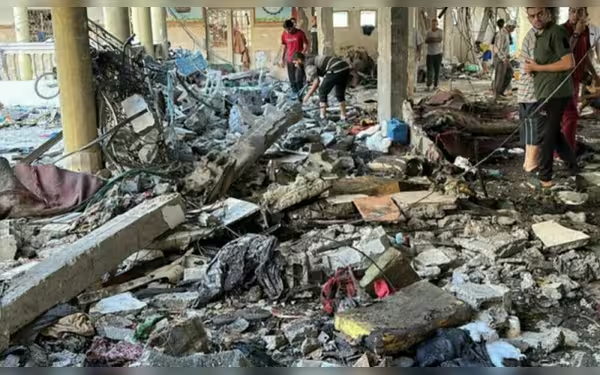Thursday, November 7, 2024 04:04 PM
Escalating Violence in Southern Beirut Amid Israeli Evacuations
- Israeli strikes intensify in southern Beirut suburbs.
- Over 1,800 casualties reported since conflict escalation.
- Negotiations for ceasefire and hostage exchange ongoing.
 Image Credits: brecorder
Image Credits: brecorderIsraeli strikes in southern Beirut escalate amid evacuation orders, with over 1,800 casualties reported since September 23.
In recent days, the situation in Lebanon has escalated dramatically, particularly in the southern suburbs of Beirut. Early Friday, at least ten strikes were reported in these areas, coinciding with evacuation orders issued by the Israeli army for buildings in regions known to be strongholds of Hezbollah. This military action follows a meeting between Israeli Prime Minister Benjamin Netanyahu and U.S. officials, where discussions centered on a potential agreement to bring an end to the ongoing conflict in Lebanon, which has seen a rising death toll on both sides of the border.
Footage from AFPTV captured the chaos, showing explosions followed by thick clouds of smoke rising from the suburbs. According to Lebanon’s National News Agency (NNA), the raids resulted in significant destruction, leveling numerous buildings and igniting fires across the targeted areas. The strikes specifically hit the suburban regions of Ghobeiry and Al-Kafaat, as well as the Sayyed Hadi Highway and the vicinity of the Al-Mujtaba Complex.
The Israeli military has intensified its bombardment of southern Beirut in recent weeks, extending its operations to other parts of the capital and throughout Lebanon. During discussions on Thursday, Netanyahu emphasized to U.S. envoys that any agreement regarding Lebanon must ensure Israel's long-term security. Israeli Defence Minister Yoav Gallant also met with American officials, focusing on security arrangements related to Lebanon and efforts to secure the release of 101 hostages held by Hamas in Gaza.
Reports from Israeli media suggest that a U.S.-brokered plan may involve Hezbollah forces retreating approximately 20 miles from the border, with Israeli troops withdrawing from Lebanon. The Lebanese army would then take control of the border, supported by UN peacekeepers. Lebanon would be tasked with preventing Hezbollah from rearming, while Israel would maintain its right to self-defense under international law.
As the conflict continues, the toll on human life has been staggering. Since fighting escalated on September 23, at least 1,829 people have lost their lives in Lebanon, according to an AFP tally. The Israeli military has reported that 37 soldiers have died since ground operations commenced on September 30. The NNA also reported strikes on Baalbek, resulting in additional casualties and destruction.
Hezbollah's new leader, Naim Qassem, has not directly linked a ceasefire in Lebanon to an end to the fighting in Gaza, stating, “If the Israelis decide that they want to stop the aggression, we say we accept, but under the conditions that we see as appropriate and suitable.” Meanwhile, U.S., Egyptian, and Qatari mediators are striving to secure a truce and a hostage exchange in the ongoing war in Gaza.
As the situation unfolds, it is clear that the conflict has deep roots and complex dynamics. The ongoing violence not only affects those directly involved but also has broader implications for regional stability. The international community watches closely, hoping for a resolution that can bring lasting peace to a region long plagued by turmoil. Understanding these developments is crucial, as they shape the future of Lebanon and its neighbors.













